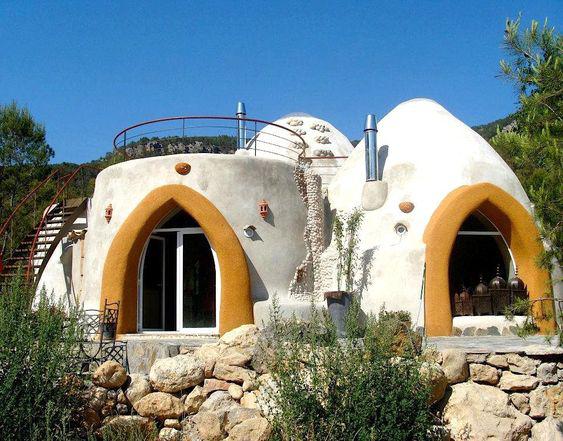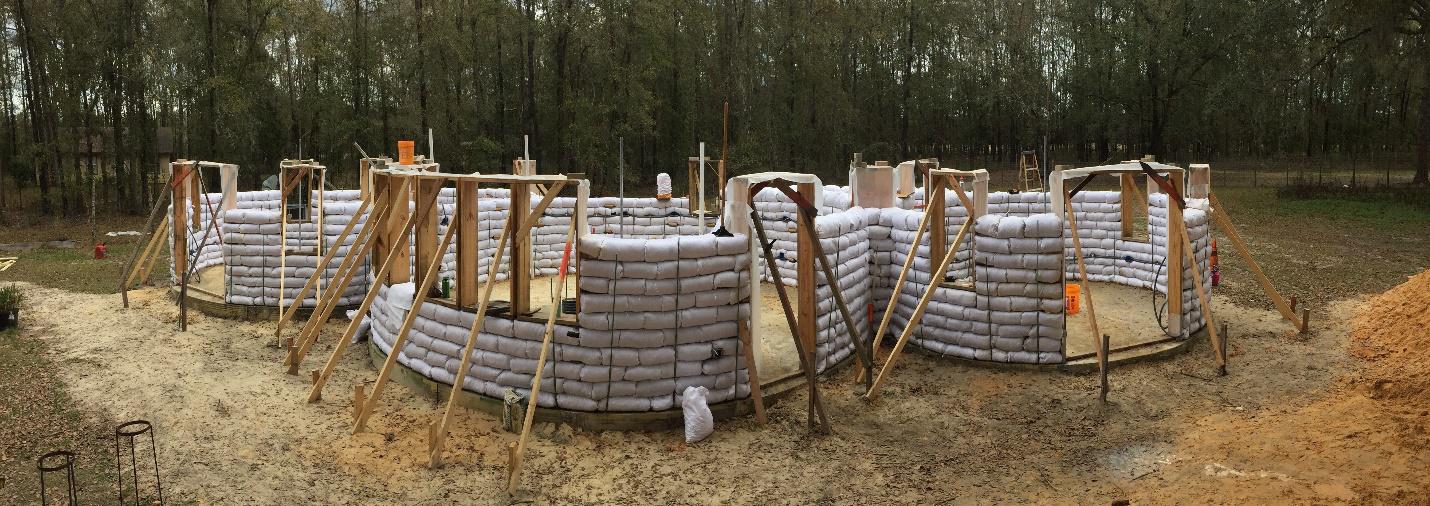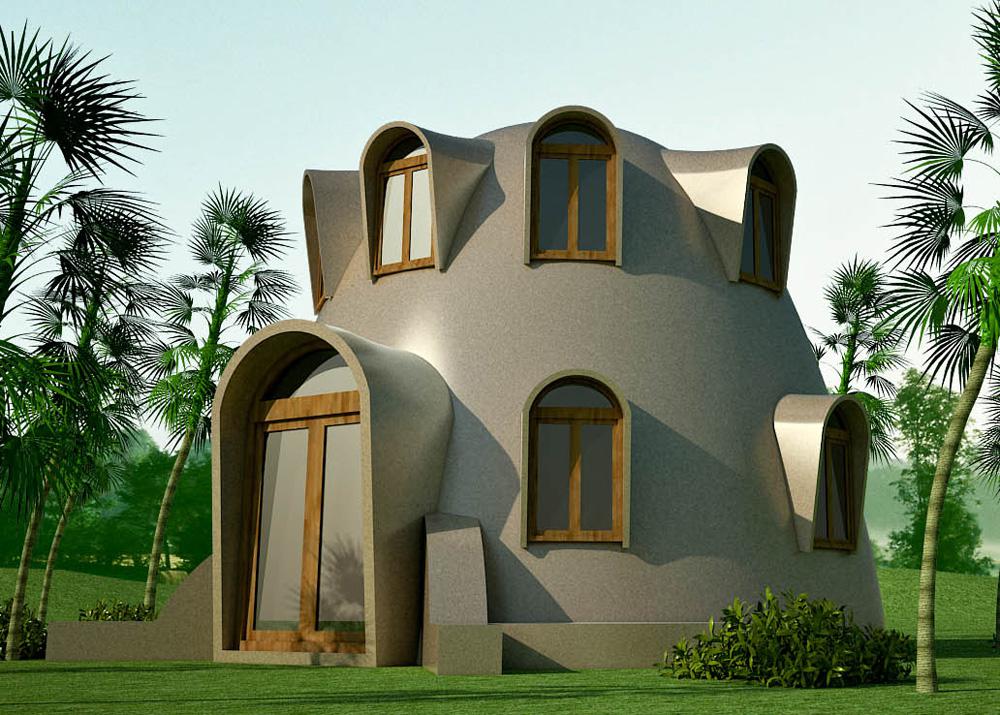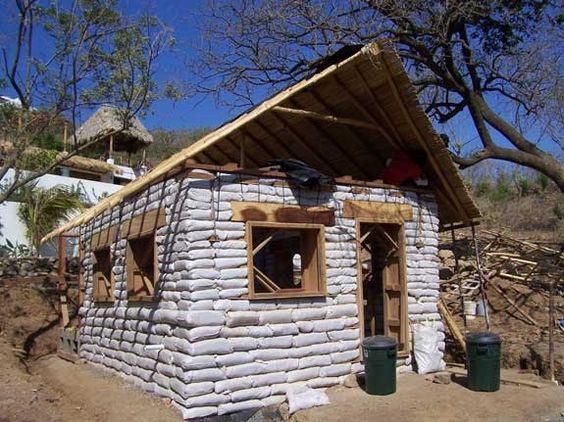Earthbag houses in south America
Earthbag houses are a cheap alternative housing method that are created by filling bags with earth materials. These bags are comprised of three main element earth, tubular bags and barbed wire. Different regions fill the bags with different or additional materials e.g. in Colombia earth bags are filled with plastic as well as the earth materials because plastic does not degrade for thousands of years, it is covered with adobe or plaster so that the plastic does not offgas or degrade.
Adobe is “essentially a dried mud brick, combining the natural elements of earth, water, and sun. It is an ancient building material usually made with tightly compacted sand, clay, and straw or grass mixed with moisture, formed into bricks, and naturally dried or baked in the sun without an oven or kiln.” (source from https://www.thoughtco.com/what-is-adobe-sustainable-energy-efficient-177943) In the Philippines long sandbags add stability, but using barbed wire between layers of shorter sand bags, is also fine.
It takes much longer to fill the long bags than the short ones. Building with earth materials is an ancient practice that has been updated recently to accommodate modern living. The earth bag method was created by an Iranian architect called Nader Khalili. It is at the low cost of $28 a square foot, the low cost is complimented by a gentle environmental impact, making it a promising solution for low income Areas.

Khalili was working in Iran creating adobe houses in Iran’s country side teaching villagers how to make their home, however when he came to the United States of America, he realized that adobe homes weren’t always practical but the earth elements could still be used. Khalili soon created supeadobe which was made by stacking sandbags on top of each other like they were bricks and using barbed wire as a type of mortar; he was asked by Nasa to create a housing method that would require minimal amount of materials.
Earthbags can be made up of an any type of soil but knowing the different compositions and mixtures of soil could help, curtain types of composition could provide stronger walls and may also provide more stability, builder primarily use a mix of clay and sand, the clay acts as a glue to hold the sand together while the loose and gritty particles from the sand provide stability. Coarse, jagged sand helps the other sand by giving it multiple sections to adhere to the clay. No matter the mixture, topsoil should not be used. Debris found in topsoil may decompose and weaken the structure.

When creating the Earthbags, the Bags should be filled on-site, right before they are placed. Earthbags can be filled in many ways e.g. As the walls get higher, bags could be lifted in place partially filled and then finished by handing up cans of dirt.
As bags are filled, they can be sewed closed with a twine, but this isn’t essential. some builders have constructed bag stands that hold a big bag upright, that way person can shovel soil into it. An alternative would be to place the open end of the bag, folded in with neat corners, against the sealed end of the adjoining bag. Tightly placing the bags keeps them closed and ensures the wall’s structural strength. Bags should be placed where the bags on the previous row meet so that they are covered by the bags on the subsequent row, just like brickwork. After a row of bags has been laid, the tamper presses the bags down into place.
This keeps the earth from shifting and keeps each layer level. The compression also forces the dirt inside the Earthbag to become a solid self-supporting form, that way if a bag was to be removed, the dirt wall would still stand. Between each layer of bags one or two strands of barbed wire is placed along the top of the row to hold the next row of bags in place. Even if the barbed wire pokes a hole in the bag, the tamping of the dirt ensures that the wall remains solid; the barbed wire may cause holes but large holes can be patched using duct tape. Ounce complete the wall should be plastered as soon as possible to avoid exposure to the sun for long periods of times

When constructing an Earthbag you may run into a few difficulties, because it is not widely known or used, dealing with building officials like banks and insurers may be difficult. Despite the integrity being tested it is not included in the building codes in most places except in the city of Hesperia and in San Bernardino County in California, thanks to architect Nader Khalili’s work with local building officials. Still, even if a bank is interested, there might be other difficulties.
Because Earthbag houses are rare, it is difficult in many areas to find a similar home. Banks use evaluated values of comparable homes to set a base value for the loan applicant’s home. If there are comparable homes, but haven’t been on the market in the past six to nine months, then they can’t be used as comparable values. If an appraiser can’t determine the value of the home, then banks can’t give the money to the person to build or buy the house.

When working with Earthbags you should look at these qualities
Can it stand a large amounts of pressure without stretching or breaking
Cheap for common use
How long will it last without degrading, especially when covered or protected by plaster
Earth bag are the newest form of green architecture made up of many pros and cons, the cons are mainly due to the hard labor that a person has to do putting the house together and unless you have friends and/or willing to help out it will take a long period of time, strenuous to your body or will be expensive to hire workers to do it for you.


Leave a Reply